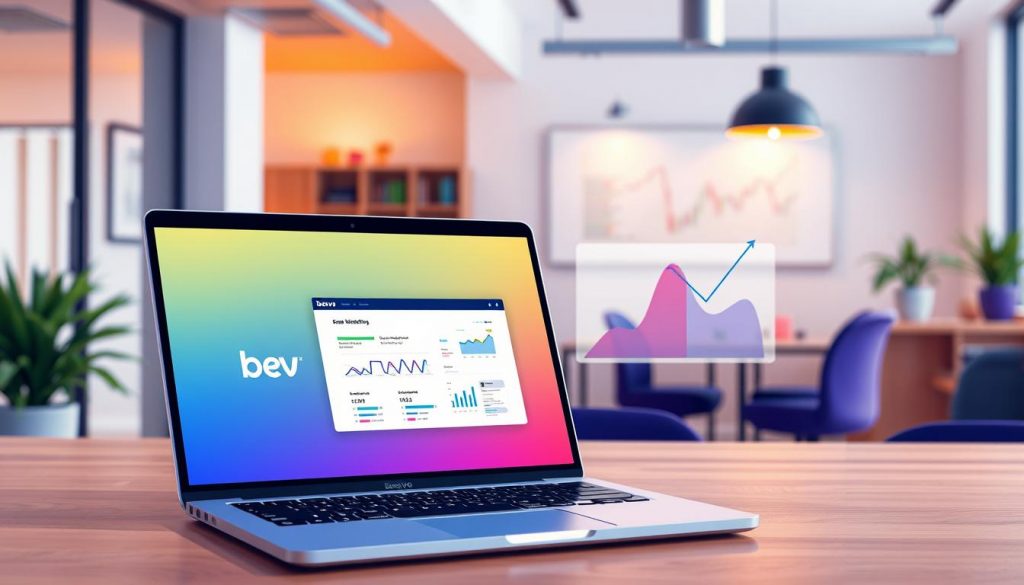This concise review is for small businesses and SMB teams that want strong marketing features without enterprise price tags.
Expect clear guidance on per-email pricing and why unlimited contacts matter for scaling campaigns. The platform’s pay-as-you-go option and a free plan that sends 300 emails per day make it simple to start without big monthly bills.
Core tools covered here include campaign creation, automation, transactional messaging, a free CRM, and multichannel outreach via SMS and WhatsApp. Editor ease, templates, and content tools are also assessed to show how quickly teams can build on-brand emails.
We’ll note plan limits and upgrades — from the free tier to Business — and where advanced A/B testing and reporting unlock better insights. The review stays practical, weighing trade-offs like free-plan caps and per-user fees so you can plan campaigns with confidence.
Key Takeaways
- Best fit: small businesses and SMBs seeking value-focused email marketing tools.
- Per-email pricing + unlimited contacts helps campaigns scale affordably.
- Includes email, SMS, WhatsApp, transactional messaging, and a free CRM.
- Free plan is useful for starters; Business plan adds A/B testing and advanced reporting.
- Templates and an easy editor speed up campaign creation for non-technical teams.
- Watch for limits on the free tier and extra cost for multiple users.
Quick Verdict for 2025: Is Brevo Right for Your Business?
For 2025, this platform stands out as a cost-conscious choice for teams that need fast, scalable email sending without list-based penalties. Its per-email pricing keeps costs predictable and can beat subscriber-based services for growing lists.
Start small: the free plan sends up to 300 emails per day with branding, so use it for proof-of-concept marketing and early campaign testing. The cap and branding make it a short-term option for most growing businesses.
The starter plan removes daily limits and suits teams that send regular emails. Note that A/B testing, landing pages, and advanced reporting remain behind the business plan.
Choose Business when optimization matters. A/B testing, advanced reporting, landing pages, predictive send time, and multi-user access (additional user fee ~ $10–$12) unlock real gains for serious teams.
- Customer support: help center resources on all plans; phone support on Business and Enterprise.
- ROI: per-email pricing often lowers costs versus subscriber-based tools.
- Extras: automation and multichannel tools expand marketing campaigns without extra platforms.
Overall, the brevo review consensus names this option strong value for 2023–2025. If you’re testing or running lean, start free or Starter. If you need optimization and collaboration, the business plan is the smarter long-term choice.
brevo review at a Glance: What’s New and Notable This Year
New updates focus on making campaign setup quicker, with better image and brand management plus richer automation.
What stands out in 2025: a smoother drag-and-drop editor with a built-in image editor and access to 8,000 stock photos. The Brand Library helps keep colors, fonts, and logos consistent across emails and templates, so campaigns look professional fast.
The automation suite now includes ready-made flows (welcome, abandoned cart, product views), website tracking, and if/else branches that make behavior-based sequences easier to build. AI assistance helps with subject lines and copy, while predictive send time is available on the Business plan.
Key limitations to consider
There are fewer out-of-the-box templates than some rivals (around 47–48+), and landing pages plus advanced analytics are gated behind Business. A/B testing also requires an upgrade, which may push data-focused teams to pay sooner.
Note that the landing page builder can feel slow or clunky compared with the email editor. Multi-user accounts add extra fees, which raise total cost as teams scale.
- Friendlier editor and AI help speed campaign assembly.
- Brand Library ensures consistent design across marketing assets.
- Automation and multichannel tools (SMS, WhatsApp, push) broaden outreach without extra platforms.
- Limitations: fewer templates, landing pages and advanced reporting behind Business, and additional user fees.
Who Brevo Is Best For in the United States
For many small companies, a per-email pricing model makes sending occasional campaigns affordable and predictable.
Small businesses and budget-conscious teams get pro-level email features without paying for large subscriber lists they rarely message. The free plan helps validate ideas, then teams can scale as needed.
SMB ecommerce stores
Stores on Shopify, WooCommerce, or Magento benefit from plug-and-play integrations. Orders sync quickly, automations trigger on purchases, and personalization boosts conversion rates.
Low-volume and transactional needs
Teams that send few messages but need reliable transactional emails like receipts, password resets, and confirmations will find SMTP relay dependable.
Multichannel reach
SMS and branded whatsapp campaigns add speed when email isn’t ideal. The WordPress plugin is widely used in the U.S. to simplify forms and on-site tracking without complex setup.
- Segmentation and filters target by behavior, purchase history, and engagement.
- Included CRM helps small sales teams manage handoffs and tasks.
- Streamlined workflows reduce time to launch for small marketing teams.
| Use Case | Key Benefit | Best For |
|---|---|---|
| Occasional campaigns | Per-email pricing keeps costs low | Small businesses |
| Ecommerce automations | Native Shopify/WooCommerce sync | SMB stores |
| Transactional delivery | SMTP relay and reliable sends | Low-volume senders |
Bottom line: if your U.S. business needs dependable email essentials, transactional and multichannel messaging, this platform checks many boxes while keeping contact management simple.
Pricing Explained: Per-Email Model, Free Plan, and Value for Money
For many small teams, pricing that charges by email sent keeps list growth from driving up costs. This per-email model lets you store unlimited contacts without jumping to a higher tier just because your database grows.
Free plan details are straightforward: you can send up to 300 emails per day with built-in branding and basic reporting. It’s a low-risk way to validate subject lines, segment choices, and audience interest before spending.
Starter removes daily caps, making it practical for regular newsletters. However, A/B testing, the landing page builder, and advanced reporting remain locked on higher tiers.
The Business plan adds A/B testing, advanced reporting, landing pages, predictive send-time, and multi-user access (additional users ~ $10–$12 each). Factor those per-user fees into collaboration budgets.
“Pay-as-you-go email credits are handy for occasional bursts and can be cheaper than a monthly plan if you send infrequently.”
- Per-email pricing is budget-friendly when you send infrequently to a large list.
- Use the free plan to test messaging with 300 emails per day and basic analytics.
- Upgrade to Starter for ongoing sends; move to Business when testing, landing pages, or advanced optimization matter.
Plans Breakdown: Emails Per Day, Email Volume, and Unlimited Contacts
Choosing the right plan comes down to how many emails you send each month, not how many contacts you store. That makes pricing predictable as your database grows.
The free plan caps sends with a daily limit and includes platform branding. If your team needs steady sends, the starter plan removes daily caps and supports ongoing newsletters and drip sequences.
How pricing scales by send volume vs. contact count
Paid tiers charge by monthly email volume rather than stored contacts. This protects you from sudden cost jumps when lists expand.
Unlimited contacts let you build deep segments, run longer nurture flows, and test audiences without raising the base plan.
When to upgrade from Free to Starter to Business
- Move off Free when your campaign cadence exceeds the emails per day cap or when branding must be removed.
- Choose Starter for consistent delivery without daily limits and standard automations.
- Upgrade to Business when you need A/B testing, landing pages, advanced reporting, or multi-user workflows to scale performance.
Seasonal spikes are covered by higher-volume tiers or email credits. Map projected monthly sends and required features up front to avoid mid-quarter surprises.
| Plan | Key Limit | When to Pick |
|---|---|---|
| Free plan | Daily send cap, branded emails | Testing, proof-of-concept, low cadence |
| Starter plan | No daily caps, basic automations | Regular newsletters and steady campaigns |
| Business plan | Advanced tools (A/B, landing pages, multi-user) | Optimization, team collaboration, deep analytics |
Core Email Features: Editor, Email Templates, and Campaign Creation
A clean, block-based editor helps teams iterate and ship campaigns without design back-and-forth. The drag-and-drop layout includes 12 content blocks, a built-in image editor, and access to 8,000+ stock photos to cut reliance on external design tools.
The editor lets you save content blocks for headers, footers, and CTAs so repeated elements load instantly. Saved blocks speed up campaign builds and keep layouts consistent across sends.
Templates, Brand Library, and design consistency
The template library offers 47–48+ responsive email templates that work across devices. Use the Brand Library to pull fonts, colors, and your logo so every new template matches your visual identity.
Personalization and conditional content
Personalization fields insert names, company, or location into content for more relevant messaging. Conditional blocks let you show different offers or product sets to segments within the same campaign.
- Tip: Build a reusable system—saved blocks + brand styles—to shorten production cycles.
- Note: A/B testing for subject lines and content is available on the Business plan for optimization needs.
Bottom line: the editor, templates, and personalization features form a practical toolkit that helps small teams run better marketing campaigns without adding headcount.
Marketing Automation: Workflows, Triggers, and Segmentation Power
A visual workflow editor helps marketers deploy tested sequences like welcome and cart recovery without coding. The builder includes ready-made journeys for welcome emails, abandoned cart flows, and product-view campaigns so teams can go live quickly.
Ready-made workflows and website triggers
Templates cut setup time. Add website tracking to trigger messages when a visitor views a product or abandons checkout. That behavior-based data keeps campaigns timely and relevant.
If/else branches, delays, and multi-entry
Use if/else conditions and time delays to tailor cadence for promos or long nurture streams. Multi-entry journeys let multiple forms or events start the same flow without creating duplicates.
Lead scoring and segmentation automation
Lead scoring ranks contacts by intent and moves high-scoring prospects to sales. Automation steps add or remove contacts from lists, update attributes, and build engagement-driven segments on autopilot.
Multichannel steps support email, SMS, WhatsApp, and push so you reach contacts where they respond best. While not as deep as some enterprise suites, the automation features cover most SMB needs and keep workflows simple to manage.
| Automation Goal | Key Tool | Best Use |
|---|---|---|
| Welcome series | Prebuilt workflow | New sign-ups |
| Abandoned cart recovery | Website trigger + delay | Ecommerce |
| Behavioral nurture | If/else branching | Product interest paths |
| Lead qualification | Lead scoring | Sales-ready contacts |
Transactional Emails, SMS, and WhatsApp Campaigns
Fast, reliable triggers for receipts and password resets make transactional messaging a backbone of any user-focused service. These messages must arrive immediately and consistently to protect user trust.
SMTP relay performance
Transactional emails like sign-ups and purchase confirmations benefit from high-speed delivery. The platform claims 50% deliver within 1 second and 99.98% within 20 seconds. Test your setup, though—SMTP-only configurations showed deliverability gaps in some cases.
Practical note: consider warming up your sending domain, keep list hygiene tight, and monitor bounce rates to protect inbox placement.

SMS credits and US pricing
SMS requires credits billed in Euros. For budgeting, an example rate is €5 for 500 US SMS. Plan accordingly for approval and monthly accounting.
WhatsApp, web and mobile push
Branded whatsapp campaigns offer timely, opt-in messaging for promos and updates. Web and mobile push notifications add another fast channel for urgent alerts.
“Combining transactional email, SMS, and WhatsApp increases the chance a time-sensitive message is seen.”
- Use the free plan to handle low-volume transactional sends while evaluating multichannel reach.
- A/B test subject lines and layouts once you can access Business features.
- If SMTP is critical-only, evaluate specialized providers like Postmark or SMTP2Go alongside this platform.
| Channel | Strength | When to Use |
|---|---|---|
| SMTP relay | Fast transactional delivery | Receipts, password resets |
| SMS (credits) | Immediate mobile reach | Time-sensitive alerts, promos |
| Branded, opt-in conversations | Customer updates and rich messages |
AI Features in 2025: Copy, Send-Time Optimization, and Support
AI now shapes how teams draft, schedule, and respond to email campaigns with speed and consistency. The platform’s assistant helps generate subject lines, body copy, and tone adjustments directly inside the editor.
AI email builder and content controls
The AI email builder is available on the free plan, so teams can test drafts without upgrading. It creates multiple subject-line options, writes body text in different tones, and offers translations to streamline campaigns.
Practical uses: you can rewrite, shorten, or expand content inside the editor to match brand voice fast. AI also helps keep automation messages consistent across sequences.
Predictive send-time and performance
Predictive send time is included on the business plan and uses past campaign data plus aggregated signals to recommend the best send windows. That feature aims to boost opens by scheduling emails when recipients are most likely to engage.
Teams should A/B test AI-produced subject lines on the business plan to validate real uplift before rolling them out at scale.
Support and Conversations
AI also enhances the Conversations module, summarizing chats and suggesting reply drafts for support agents. This reduces response time and keeps messaging consistent between sales and marketing.
- Speed up production with quick subject and body drafts.
- Use rewrite and translate tools to adapt content for segments.
- Leverage predictive send time on the business plan for better opens.
| AI Feature | Where It Appears | Benefit |
|---|---|---|
| AI email builder | Editor (free plan included) | Faster copy creation and tone control |
| Predictive send time | Business plan | Improved open rates via smarter scheduling |
| Conversations summaries | Support module | Faster replies and consistent customer messaging |
Brevo CRM: Sales Pipelines, Tasks, and Marketing-to-Sales Handoff
A built-in CRM helps small teams track deals, assign tasks, and close leads without hopping between tools. It packages basic sales pipeline views, task reminders, and deal tracking into the same platform you use for email and campaigns.
Free CRM capabilities for SMB workflows
The free CRM organizes deals into pipelines with clear stages and next-action tasks. Reps see what’s due, get automatic reminders, and can update deal status in seconds.
Marketing automation and lead scoring help pass qualified contacts to sales. When a contact hits your score threshold, the system can create an MQL task, assign an owner, and notify the rep.
- Store contact, campaign, and deal data together for richer follow-up and personalization.
- Automate deal-stage updates from campaign engagement and add automatic reminders.
- Examples: new MQL task creation, deal stage moves after an email click, and auto-reminders before renewals.
The CRM is free, which makes it easy for small businesses to align marketing and sales without extra subscriptions. Define qualification criteria, map lead scores, and run regular alignment meetings to keep pipelines healthy.
“Consolidating contact, campaign, and deal data speeds follow-up and improves revenue predictability.”
Forms and Landing Pages: Lead Capture Without the Headaches?
Forms that pre-fill from an email link reduce friction and lift conversions on promos and gated content.
Create sign-up forms with list selection and custom fields so new leads map directly to your contact records. Use double opt-in for compliance and better deliverability—this also improves long-term inbox placement.
Note the limitations: there are no pre-made form templates and no A/B testing for forms. That slows experimentation and means you may iterate more manually.
Landing page builder: what to expect
The landing page builder lives on Business. It supports SEO settings, tracking-code injection, and custom domains so you can host on your own subdomain.
Be aware the editor can feel clunky and slow, and included pages are limited unless you pay for extras. Plan extra time for mobile polish and tweaks.
- Practical tip: pair forms with targeted email content to capture context-rich leads for segments and automations.
- For the free plan, embed forms on existing site pages to validate offers before upgrading for a landing page.
Quick checklist: custom fields mapped to contacts, UTM tracking, and post-submit automation for instant follow-up. Capture works well, but landing sophistication may require Business or an external builder that syncs leads back to the platform.
“Use double opt-in and pre-filled fields to protect deliverability and raise conversions.”
Integrations and API: WordPress Plugin, Ecommerce, and More
Connect your store, CRM, and web forms quickly so data flows into campaigns and automations. That makes behavior-based messaging and segmentation practical for small teams.

Top native integrations and Zapier/Make.com coverage
The platform links with 64+ third-party apps, including Shopify, WooCommerce, WordPress, Pipedrive, and Salesforce. These native hooks sync orders, customer attributes, and events into segments and workflows.
- Zapier and Make.com extend interoperability to 5,000+ apps, reducing manual data work across your stack.
- Use direct integrations to import contacts or upload CSVs when migrating lists quickly.
WordPress plugin adoption and on-site tracking
The WordPress plugin has 80,000+ active installs and a 4.5-star rating. It simplifies embedding forms, enabling on-site tracking, and firing automations from page events.
On-site tracking helps personalize email, SMS, and WhatsApp campaigns by tying browsing behavior to contact attributes.
Developer and API notes: the REST API supports custom flows and niche system wiring so developers can centralize campaign data and keep tools in sync.
- Sync ecommerce data into segments for abandoned cart recovery and product recommendations.
- Map events and attributes consistently so personalization works across channels.
- Support documentation and email support help when wiring complex integrations.
“Integrations make the platform fit neatly into existing U.S. SMB tech stacks, cutting manual work and improving timing for outreach.”
Deliverability, Authentication, and Compliance
Protecting your sending reputation requires domain alignment and careful volume increases. Proper setup helps emails land in inboxes at major providers like Gmail and Yahoo.
Start with authentication: set up SPF, DKIM, and DMARC using the platform’s guided wizard. These records prove your domain is allowed to send and reduce the chance messages are flagged as spam.
Gmail/Yahoo readiness and complaint handling
Enable list-unsubscribe headers and feedback loop handling so mailbox providers can report complaints. That reduces spam complaints and protects long-term reputation.
IP warmup, domain alignment, and link tracking
When you increase volume beyond a few emails per day, warm up your IP gradually and monitor engagement. Use a verified from-domain and consistent reply addresses for clear domain alignment.
Note: custom link tracking domains require higher tiers, so brand-aligned tracking URLs may need an upgrade.
- Limitations: there’s a deliverability dashboard and authentication guides, but no built-in list cleaning or spam-testing tools.
- Automations: bounces and complaints are suppressed automatically to protect sender health.
- Transactional emails: these need the same authentication care and stable IP health as marketing sends.
“Monitor engagement, remove bounces fast, and use confirmed opt-in to keep your sender score healthy.”
Deliverability hygiene checklist: confirmed opt-in, segment unengaged contacts, control cadence, suppress hard bounces, and consult help center docs or support if setup errors appear.
Reporting and Analytics: From Basics to Business-Level Insights
Good reporting turns raw send data into clear actions that improve the next campaign. Use dashboards to spot trends fast and decide which creative or timing changes to test next.
Campaign metrics, click maps, and GA/UTM tracking
Core dashboards show sends, opens, clicks, and unsubscribes so you can compare campaign performance at a glance.
Link-level tracking feeds UTM tags into Google Analytics to tie email traffic to site conversions. That makes ROI clearer for marketing campaigns.
What’s locked behind the Business plan
Business plan users get click maps and advanced reporting tools. Click maps offer a visual view of what elements drive engagement on your landing page or email layout.
Starter plans see basic metrics but may lack link-level click detail and A/B testing summaries. Ecommerce integrations can surface revenue data, but full conversion reports sit with higher tiers.
- Save winning email templates and reuse high-performing blocks.
- Set a reporting cadence: weekly rollups and monthly cohort analysis.
- A/B test winners on Business with confidence indicators before scaling.
| Report Type | Visible on Starter | Visible on Business |
|---|---|---|
| Sends, Opens, Clicks, Unsubscribes | Yes | Yes |
| Link-level click details | Limited | Full |
| Click maps | No | Yes |
| A/B testing summaries | No | Yes |
| Revenue / conversion tie-ins (ecommerce) | Depends on integration | Full visibility |
“Basics cover what most teams need, but Business-level insights help optimize creative and timing decisions at scale.”
Ease of Use and Onboarding: From Signup to First Campaign
Getting started should feel quick and obvious. Most teams can register, verify, and reach a working campaign in minutes thanks to clear prompts and guided flows. The platform walks new users through business details, contact import, and template selection so you don’t stall on setup.
Getting started timeline and guided workflows
Quick onboarding flow: create an account, confirm via email, answer a few business questions, and you land in a setup wizard that stages every next step.
The guided workflows lead you to import contacts, pick a starter template, and schedule your first send. Each step shows simple tips and links to support if you need extra help.
Contact import accepts CSV and XLSX, plus copy/paste. Field mapping is visual and easy, so names, emails, and custom attributes line up without manual cleanup.
The interface is consistent across tools, which lowers the learning curve for non-technical marketers. Set up the Brand Library early and future messages stay on-brand automatically.
Practical checklist to finish onboarding fast:
- Authenticate your domain
- Import contacts and map fields
- Send the first email using a starter template
- Create a basic segment
- Enable website tracking before building automations
Support is reachable from the platform header at any time, and the help center is available on every page. That makes it simple to move from signup to sending without delay. Overall, the design favors easy use while still offering room to scale into advanced marketing tools and plans as you grow.
Customer Support and Resources in 2025
Customer support blends a searchable help center with structured courses to get teams moving fast. The learning hub pairs short lessons with practical guides for common tasks like authentication and integrations.
Help center, Academy, and channels
The help center covers step-by-step tutorials and API tips. Brevo Academy offers bite-sized courses for beginners and marketers who need a quick ramp.
- Email support is available on every plan.
- Phone support is reserved for Business and Enterprise users, weekdays only.
- Live chat exists but response quality can vary and complex issues may require follow-up emails.
Multi-user access and permissions
The Business plan unlocks granular roles so managers limit access to campaigns, contacts, and settings. Expect per-user fees (~$10–$12/month) for additional seats.
“Document internal workflows and designate a platform admin to speed support resolution.”
Practical tips: use the help center for auth and plugin guides, assign one admin to centralize knowledge, and plan for extra support when enabling landing pages, A/B testing, or advanced features.
Bottom line: resources are robust; the most responsive channels and advanced help arrive with higher plans.
Pros and Cons Recap: The Bottom-Line Assessment
Here’s a concise tally of what makes this platform valuable and where it might fall short for certain teams.
Where it offers standout value
Cost-effective plans and per-email billing let small businesses store unlimited contacts without list-based price jumps.
Practical automation features — visual workflows, prebuilt journeys, and lead scoring — cover most marketing automation needs for SMBs.
Multichannel reach with email, SMS, and WhatsApp plus dependable transactional delivery makes campaigns and receipts reliable.
The included free CRM and a popular WordPress plugin simplify adoption for teams that want fewer tools to manage.
AI assistance speeds copy creation and subject-line testing so small teams can ship more campaigns without extra headcount.
Where competitors may be a better fit
Limitations are real: the free plan has a daily cap, and A/B testing plus landing pages live on the Business tier. Multi-user seats add per-user fees that raise costs for growing teams.
Template count is lower than some rivals, and the landing page editor can feel clunkier than specialized builders.
Deliverability tooling is solid, but there’s no built-in list-cleaning or advanced spam-testing that some dedicated platforms include.
“For many small businesses, the balance of price, features, and tools is hard to beat.”
- Consider a dedicated SMTP provider if your priority is high-volume transactional emails.
- Use MailerLite or similar for landing-page-heavy funnels, or ActiveCampaign for deeper automation needs.
- Overall: this brevo review finds the offering a smart, scalable choice for U.S. SMBs that value affordability plus capable automation.
Conclusion
Summing up: this brevo review finds strong value for small businesses that want predictable per-email pricing, unlimited contacts, and a free CRM to centralize outreach.
Start small: try the free plan (300 emails per day) to validate fit. Move to Starter for steady sends and choose Business when A/B testing, landing pages, and advanced reporting matter.
As an email marketing tool, it grows with automation templates, AI help, and multichannel options (email, SMS, WhatsApp). Map your marketing campaigns to templates, personalization, and AI to speed production.
Next step: trial the free plan, authenticate your domain, import a test list, and send a first on-brand email this week. With the right plan and steady optimization, brevo offers a durable, ROI-focused platform for U.S. teams.


